Financial Performance Evaluation: Sky PLC - AC4410 Ratio Analysis
VerifiedAdded on 2023/06/13
|14
|3022
|302
Report
AI Summary
This report provides a detailed financial analysis of Sky plc, a European media and telecommunications company, using ratio analysis based on its financial statements from 2014 to 2017. It evaluates profitability, activity/efficiency, liquidity, capital structure, and investor ratios, including return on cap...
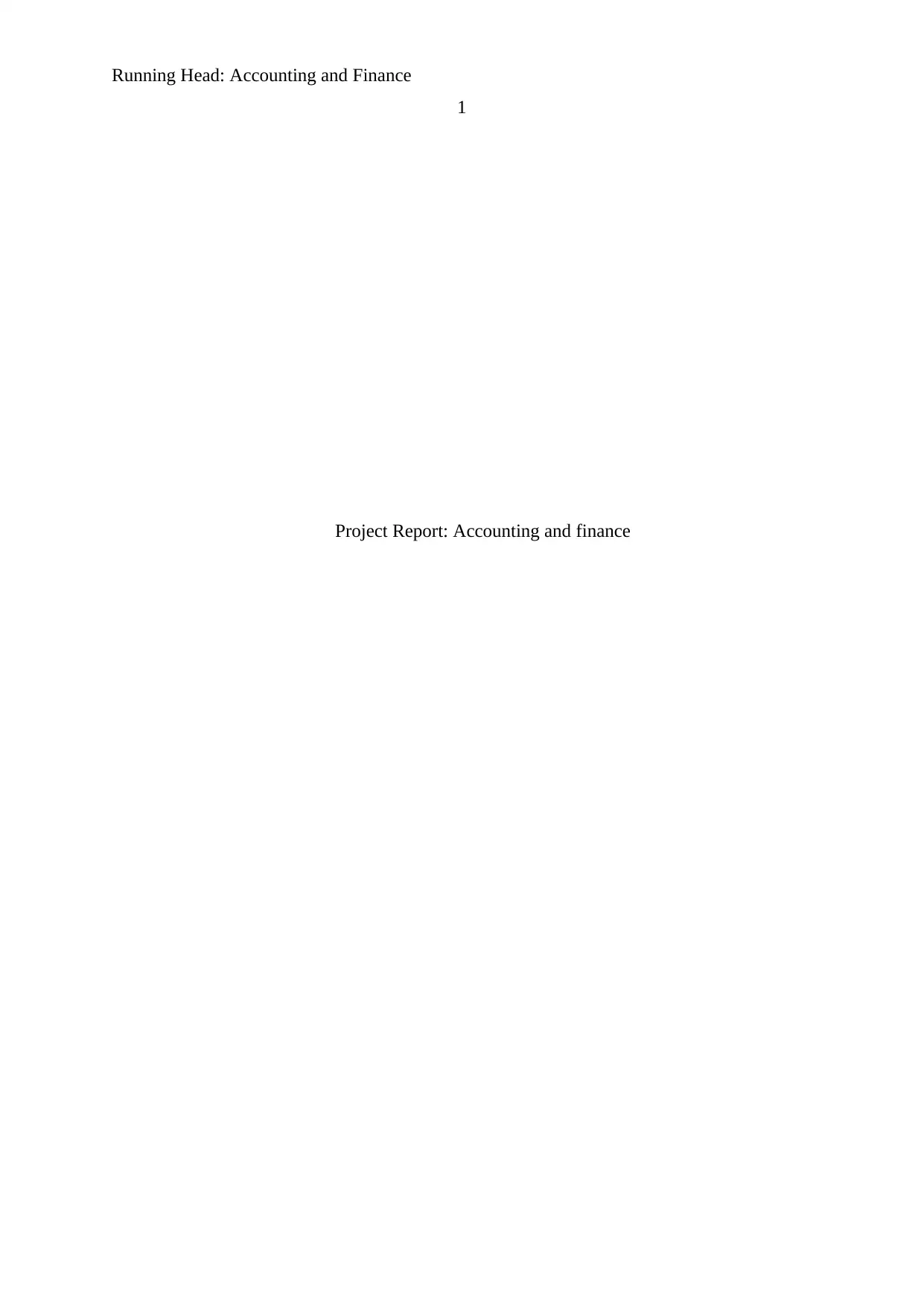
Running Head: Accounting and Finance
1
Project Report: Accounting and finance
1
Project Report: Accounting and finance
Paraphrase This Document
Need a fresh take? Get an instant paraphrase of this document with our AI Paraphraser
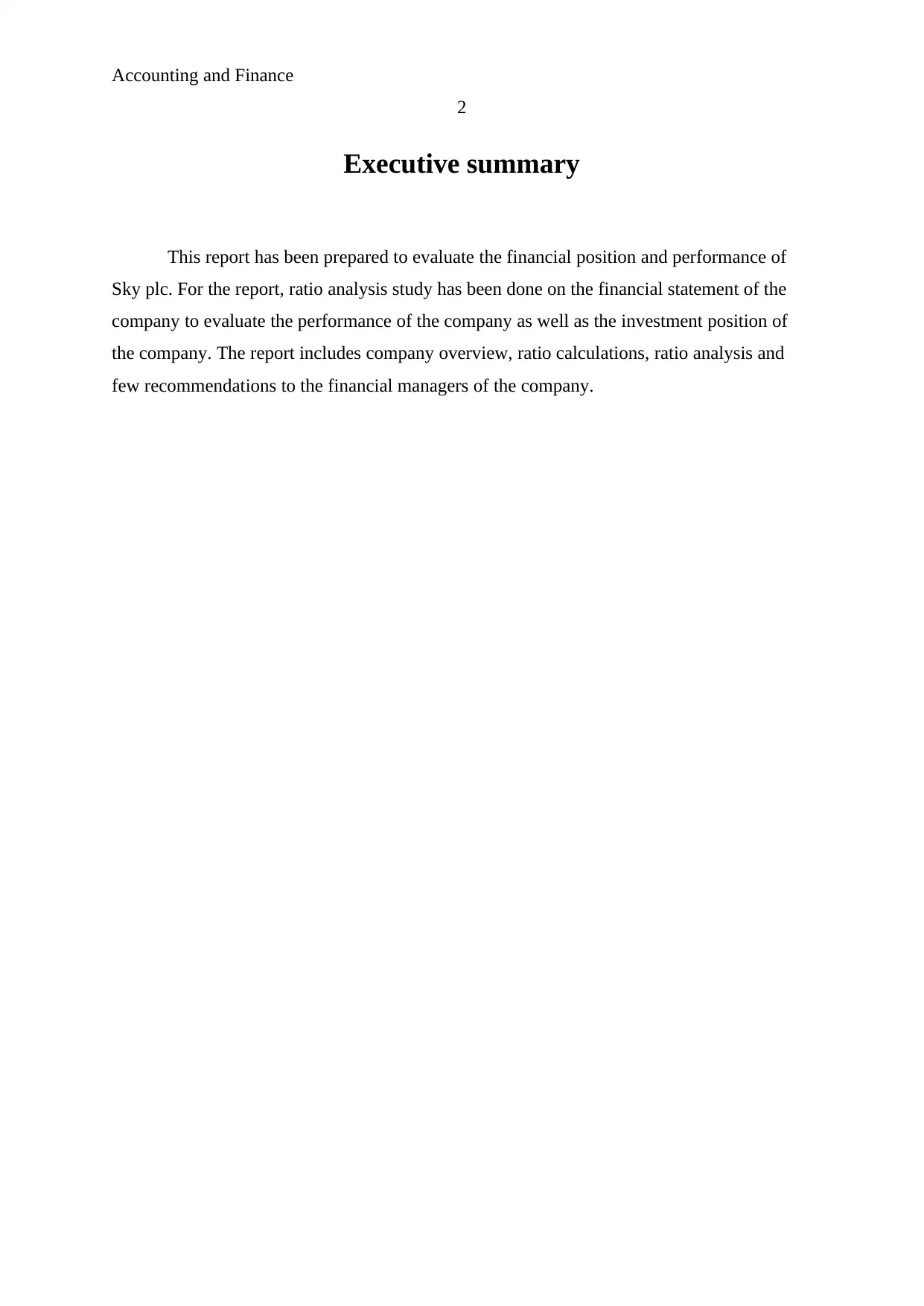
Accounting and Finance
2
Executive summary
This report has been prepared to evaluate the financial position and performance of
Sky plc. For the report, ratio analysis study has been done on the financial statement of the
company to evaluate the performance of the company as well as the investment position of
the company. The report includes company overview, ratio calculations, ratio analysis and
few recommendations to the financial managers of the company.
2
Executive summary
This report has been prepared to evaluate the financial position and performance of
Sky plc. For the report, ratio analysis study has been done on the financial statement of the
company to evaluate the performance of the company as well as the investment position of
the company. The report includes company overview, ratio calculations, ratio analysis and
few recommendations to the financial managers of the company.
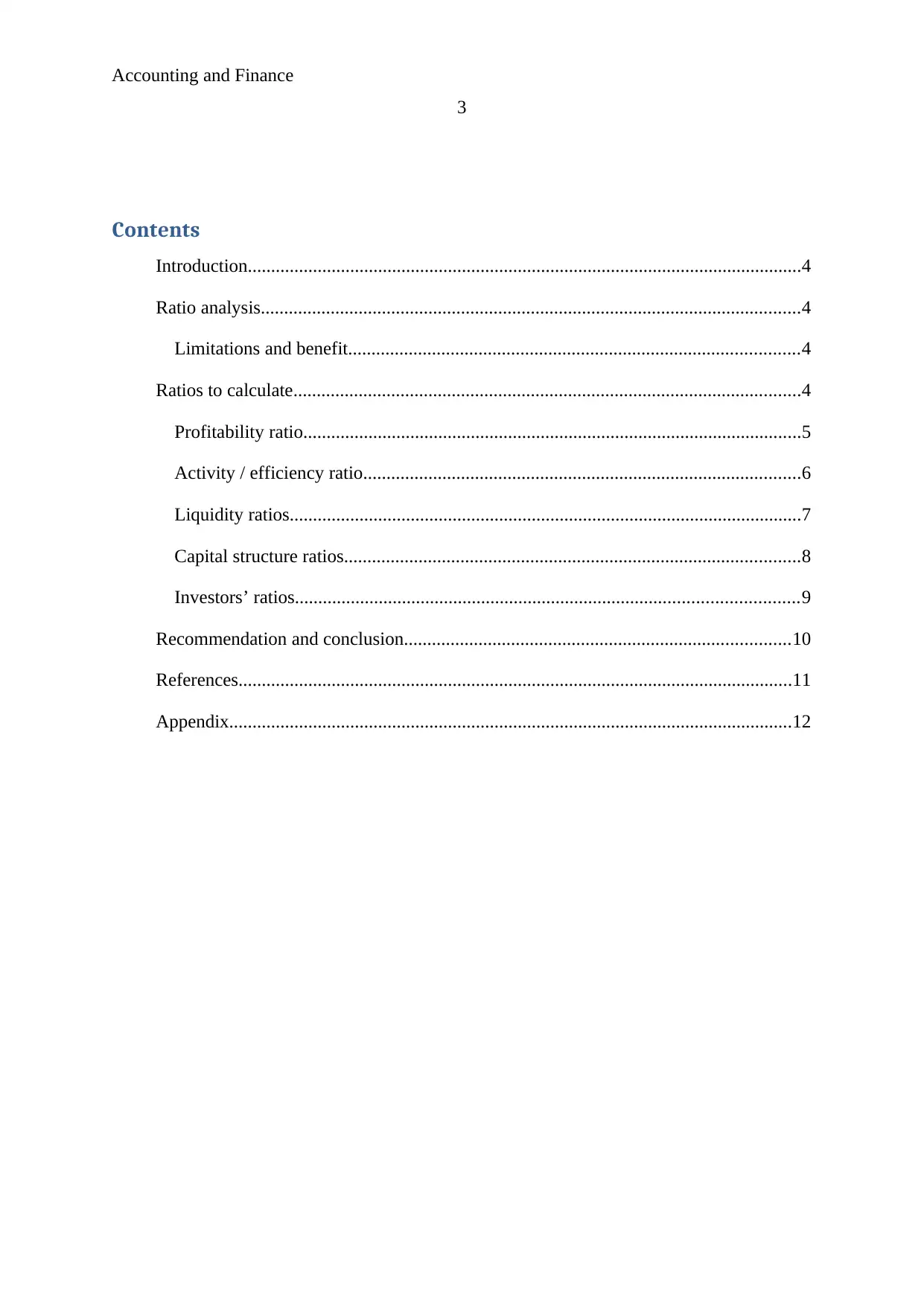
Accounting and Finance
3
Contents
Introduction.......................................................................................................................4
Ratio analysis....................................................................................................................4
Limitations and benefit.................................................................................................4
Ratios to calculate.............................................................................................................4
Profitability ratio...........................................................................................................5
Activity / efficiency ratio..............................................................................................6
Liquidity ratios..............................................................................................................7
Capital structure ratios..................................................................................................8
Investors’ ratios............................................................................................................9
Recommendation and conclusion...................................................................................10
References.......................................................................................................................11
Appendix.........................................................................................................................12
3
Contents
Introduction.......................................................................................................................4
Ratio analysis....................................................................................................................4
Limitations and benefit.................................................................................................4
Ratios to calculate.............................................................................................................4
Profitability ratio...........................................................................................................5
Activity / efficiency ratio..............................................................................................6
Liquidity ratios..............................................................................................................7
Capital structure ratios..................................................................................................8
Investors’ ratios............................................................................................................9
Recommendation and conclusion...................................................................................10
References.......................................................................................................................11
Appendix.........................................................................................................................12
⊘ This is a preview!⊘
Do you want full access?
Subscribe today to unlock all pages.

Trusted by 1+ million students worldwide
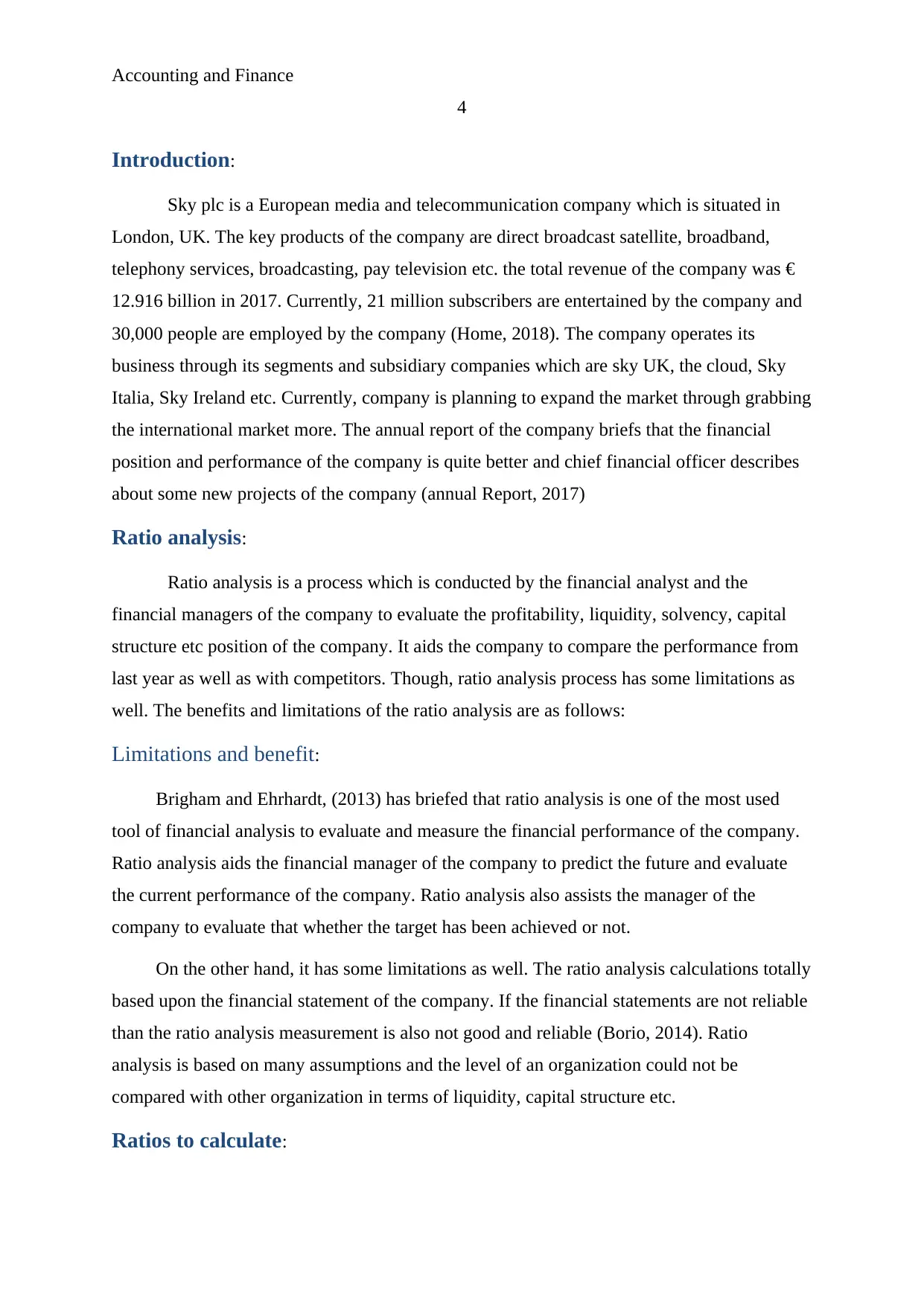
Accounting and Finance
4
Introduction:
Sky plc is a European media and telecommunication company which is situated in
London, UK. The key products of the company are direct broadcast satellite, broadband,
telephony services, broadcasting, pay television etc. the total revenue of the company was €
12.916 billion in 2017. Currently, 21 million subscribers are entertained by the company and
30,000 people are employed by the company (Home, 2018). The company operates its
business through its segments and subsidiary companies which are sky UK, the cloud, Sky
Italia, Sky Ireland etc. Currently, company is planning to expand the market through grabbing
the international market more. The annual report of the company briefs that the financial
position and performance of the company is quite better and chief financial officer describes
about some new projects of the company (annual Report, 2017)
Ratio analysis:
Ratio analysis is a process which is conducted by the financial analyst and the
financial managers of the company to evaluate the profitability, liquidity, solvency, capital
structure etc position of the company. It aids the company to compare the performance from
last year as well as with competitors. Though, ratio analysis process has some limitations as
well. The benefits and limitations of the ratio analysis are as follows:
Limitations and benefit:
Brigham and Ehrhardt, (2013) has briefed that ratio analysis is one of the most used
tool of financial analysis to evaluate and measure the financial performance of the company.
Ratio analysis aids the financial manager of the company to predict the future and evaluate
the current performance of the company. Ratio analysis also assists the manager of the
company to evaluate that whether the target has been achieved or not.
On the other hand, it has some limitations as well. The ratio analysis calculations totally
based upon the financial statement of the company. If the financial statements are not reliable
than the ratio analysis measurement is also not good and reliable (Borio, 2014). Ratio
analysis is based on many assumptions and the level of an organization could not be
compared with other organization in terms of liquidity, capital structure etc.
Ratios to calculate:
4
Introduction:
Sky plc is a European media and telecommunication company which is situated in
London, UK. The key products of the company are direct broadcast satellite, broadband,
telephony services, broadcasting, pay television etc. the total revenue of the company was €
12.916 billion in 2017. Currently, 21 million subscribers are entertained by the company and
30,000 people are employed by the company (Home, 2018). The company operates its
business through its segments and subsidiary companies which are sky UK, the cloud, Sky
Italia, Sky Ireland etc. Currently, company is planning to expand the market through grabbing
the international market more. The annual report of the company briefs that the financial
position and performance of the company is quite better and chief financial officer describes
about some new projects of the company (annual Report, 2017)
Ratio analysis:
Ratio analysis is a process which is conducted by the financial analyst and the
financial managers of the company to evaluate the profitability, liquidity, solvency, capital
structure etc position of the company. It aids the company to compare the performance from
last year as well as with competitors. Though, ratio analysis process has some limitations as
well. The benefits and limitations of the ratio analysis are as follows:
Limitations and benefit:
Brigham and Ehrhardt, (2013) has briefed that ratio analysis is one of the most used
tool of financial analysis to evaluate and measure the financial performance of the company.
Ratio analysis aids the financial manager of the company to predict the future and evaluate
the current performance of the company. Ratio analysis also assists the manager of the
company to evaluate that whether the target has been achieved or not.
On the other hand, it has some limitations as well. The ratio analysis calculations totally
based upon the financial statement of the company. If the financial statements are not reliable
than the ratio analysis measurement is also not good and reliable (Borio, 2014). Ratio
analysis is based on many assumptions and the level of an organization could not be
compared with other organization in terms of liquidity, capital structure etc.
Ratios to calculate:
Paraphrase This Document
Need a fresh take? Get an instant paraphrase of this document with our AI Paraphraser
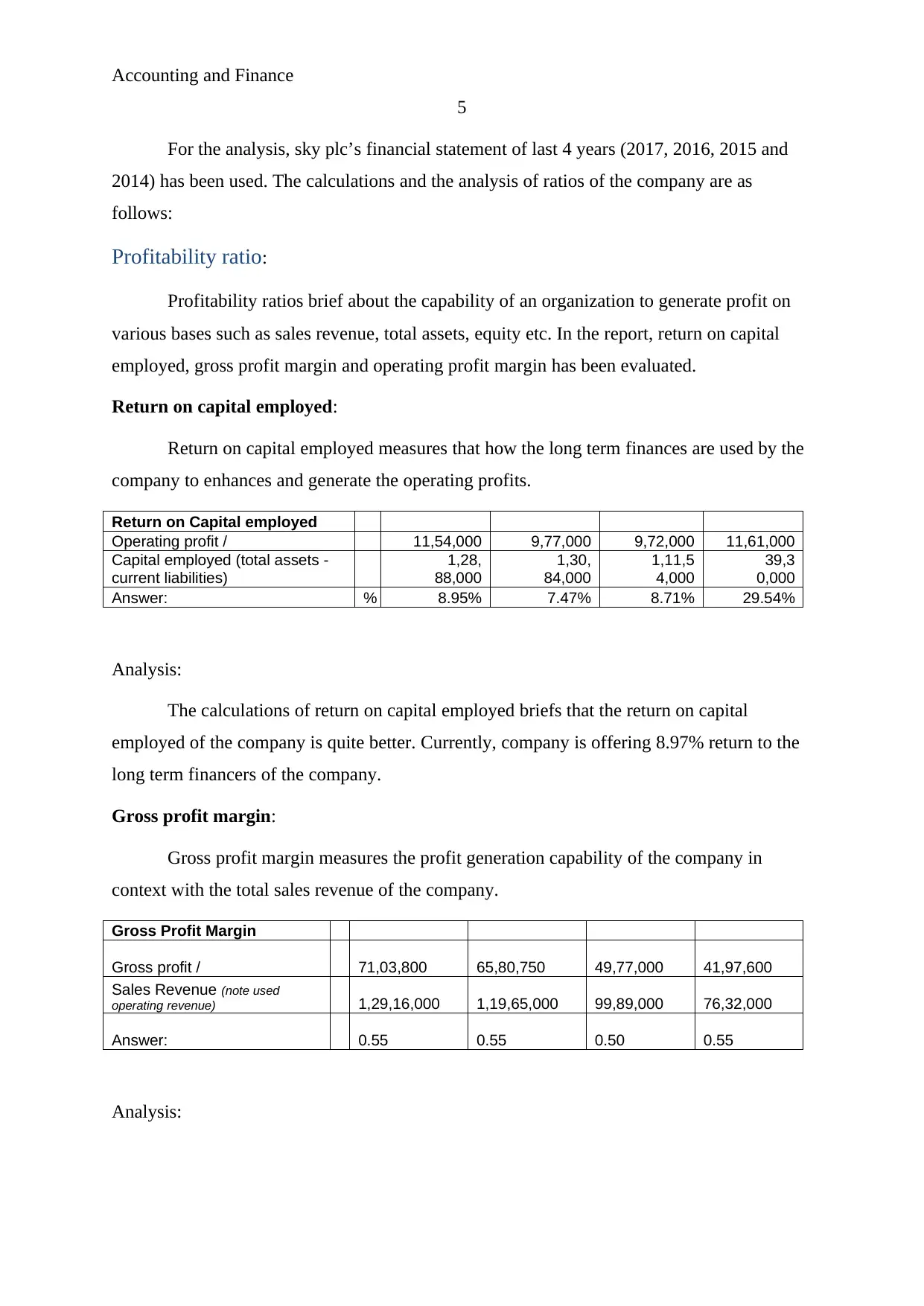
Accounting and Finance
5
For the analysis, sky plc’s financial statement of last 4 years (2017, 2016, 2015 and
2014) has been used. The calculations and the analysis of ratios of the company are as
follows:
Profitability ratio:
Profitability ratios brief about the capability of an organization to generate profit on
various bases such as sales revenue, total assets, equity etc. In the report, return on capital
employed, gross profit margin and operating profit margin has been evaluated.
Return on capital employed:
Return on capital employed measures that how the long term finances are used by the
company to enhances and generate the operating profits.
Return on Capital employed
Operating profit / 11,54,000 9,77,000 9,72,000 11,61,000
Capital employed (total assets -
current liabilities)
1,28,
88,000
1,30,
84,000
1,11,5
4,000
39,3
0,000
Answer: % 8.95% 7.47% 8.71% 29.54%
Analysis:
The calculations of return on capital employed briefs that the return on capital
employed of the company is quite better. Currently, company is offering 8.97% return to the
long term financers of the company.
Gross profit margin:
Gross profit margin measures the profit generation capability of the company in
context with the total sales revenue of the company.
Gross Profit Margin
Gross profit / 71,03,800 65,80,750 49,77,000 41,97,600
Sales Revenue (note used
operating revenue) 1,29,16,000 1,19,65,000 99,89,000 76,32,000
Answer: 0.55 0.55 0.50 0.55
Analysis:
5
For the analysis, sky plc’s financial statement of last 4 years (2017, 2016, 2015 and
2014) has been used. The calculations and the analysis of ratios of the company are as
follows:
Profitability ratio:
Profitability ratios brief about the capability of an organization to generate profit on
various bases such as sales revenue, total assets, equity etc. In the report, return on capital
employed, gross profit margin and operating profit margin has been evaluated.
Return on capital employed:
Return on capital employed measures that how the long term finances are used by the
company to enhances and generate the operating profits.
Return on Capital employed
Operating profit / 11,54,000 9,77,000 9,72,000 11,61,000
Capital employed (total assets -
current liabilities)
1,28,
88,000
1,30,
84,000
1,11,5
4,000
39,3
0,000
Answer: % 8.95% 7.47% 8.71% 29.54%
Analysis:
The calculations of return on capital employed briefs that the return on capital
employed of the company is quite better. Currently, company is offering 8.97% return to the
long term financers of the company.
Gross profit margin:
Gross profit margin measures the profit generation capability of the company in
context with the total sales revenue of the company.
Gross Profit Margin
Gross profit / 71,03,800 65,80,750 49,77,000 41,97,600
Sales Revenue (note used
operating revenue) 1,29,16,000 1,19,65,000 99,89,000 76,32,000
Answer: 0.55 0.55 0.50 0.55
Analysis:
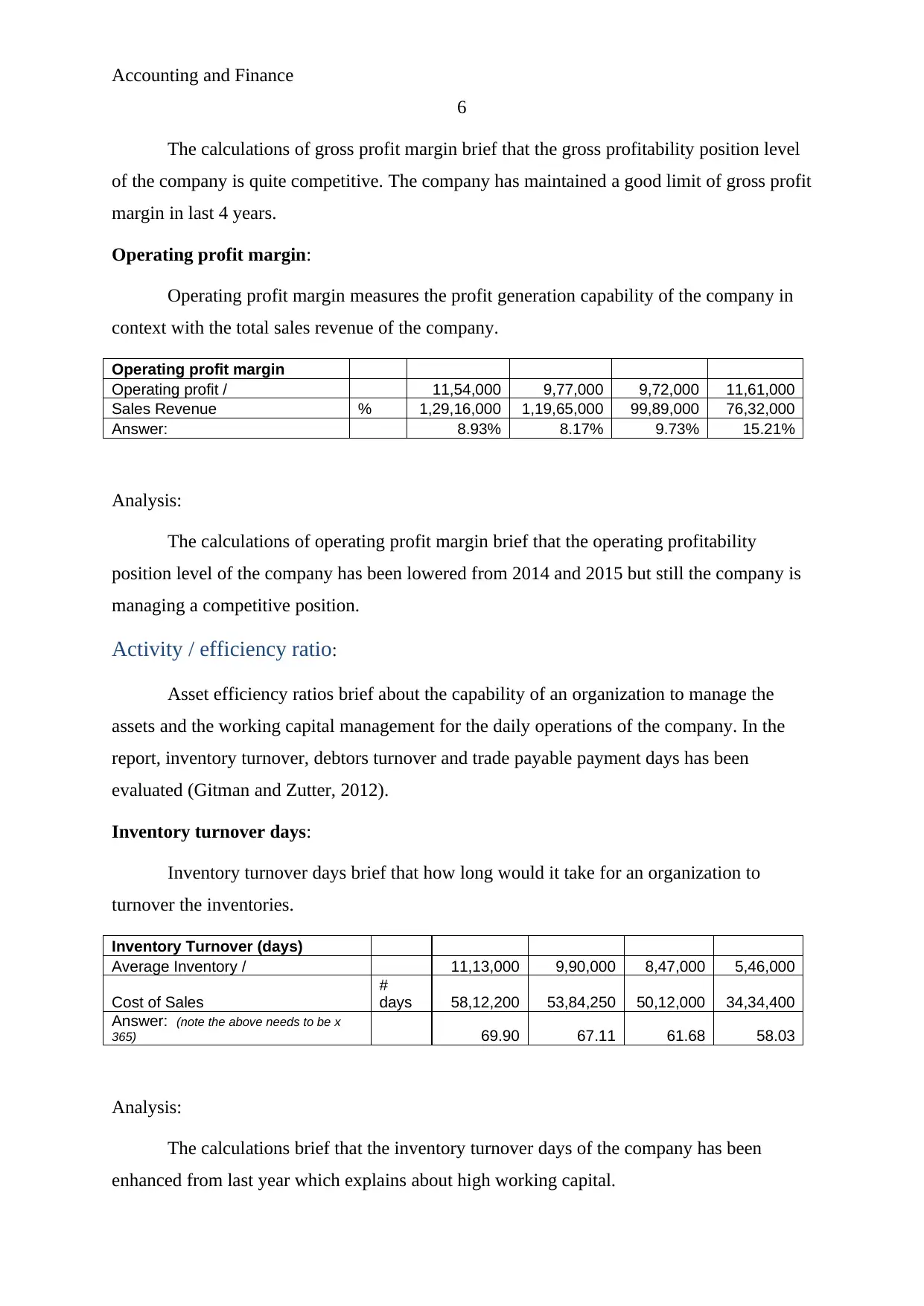
Accounting and Finance
6
The calculations of gross profit margin brief that the gross profitability position level
of the company is quite competitive. The company has maintained a good limit of gross profit
margin in last 4 years.
Operating profit margin:
Operating profit margin measures the profit generation capability of the company in
context with the total sales revenue of the company.
Operating profit margin
Operating profit / 11,54,000 9,77,000 9,72,000 11,61,000
Sales Revenue % 1,29,16,000 1,19,65,000 99,89,000 76,32,000
Answer: 8.93% 8.17% 9.73% 15.21%
Analysis:
The calculations of operating profit margin brief that the operating profitability
position level of the company has been lowered from 2014 and 2015 but still the company is
managing a competitive position.
Activity / efficiency ratio:
Asset efficiency ratios brief about the capability of an organization to manage the
assets and the working capital management for the daily operations of the company. In the
report, inventory turnover, debtors turnover and trade payable payment days has been
evaluated (Gitman and Zutter, 2012).
Inventory turnover days:
Inventory turnover days brief that how long would it take for an organization to
turnover the inventories.
Inventory Turnover (days)
Average Inventory / 11,13,000 9,90,000 8,47,000 5,46,000
Cost of Sales
#
days 58,12,200 53,84,250 50,12,000 34,34,400
Answer: (note the above needs to be x
365) 69.90 67.11 61.68 58.03
Analysis:
The calculations brief that the inventory turnover days of the company has been
enhanced from last year which explains about high working capital.
6
The calculations of gross profit margin brief that the gross profitability position level
of the company is quite competitive. The company has maintained a good limit of gross profit
margin in last 4 years.
Operating profit margin:
Operating profit margin measures the profit generation capability of the company in
context with the total sales revenue of the company.
Operating profit margin
Operating profit / 11,54,000 9,77,000 9,72,000 11,61,000
Sales Revenue % 1,29,16,000 1,19,65,000 99,89,000 76,32,000
Answer: 8.93% 8.17% 9.73% 15.21%
Analysis:
The calculations of operating profit margin brief that the operating profitability
position level of the company has been lowered from 2014 and 2015 but still the company is
managing a competitive position.
Activity / efficiency ratio:
Asset efficiency ratios brief about the capability of an organization to manage the
assets and the working capital management for the daily operations of the company. In the
report, inventory turnover, debtors turnover and trade payable payment days has been
evaluated (Gitman and Zutter, 2012).
Inventory turnover days:
Inventory turnover days brief that how long would it take for an organization to
turnover the inventories.
Inventory Turnover (days)
Average Inventory / 11,13,000 9,90,000 8,47,000 5,46,000
Cost of Sales
#
days 58,12,200 53,84,250 50,12,000 34,34,400
Answer: (note the above needs to be x
365) 69.90 67.11 61.68 58.03
Analysis:
The calculations brief that the inventory turnover days of the company has been
enhanced from last year which explains about high working capital.
⊘ This is a preview!⊘
Do you want full access?
Subscribe today to unlock all pages.

Trusted by 1+ million students worldwide
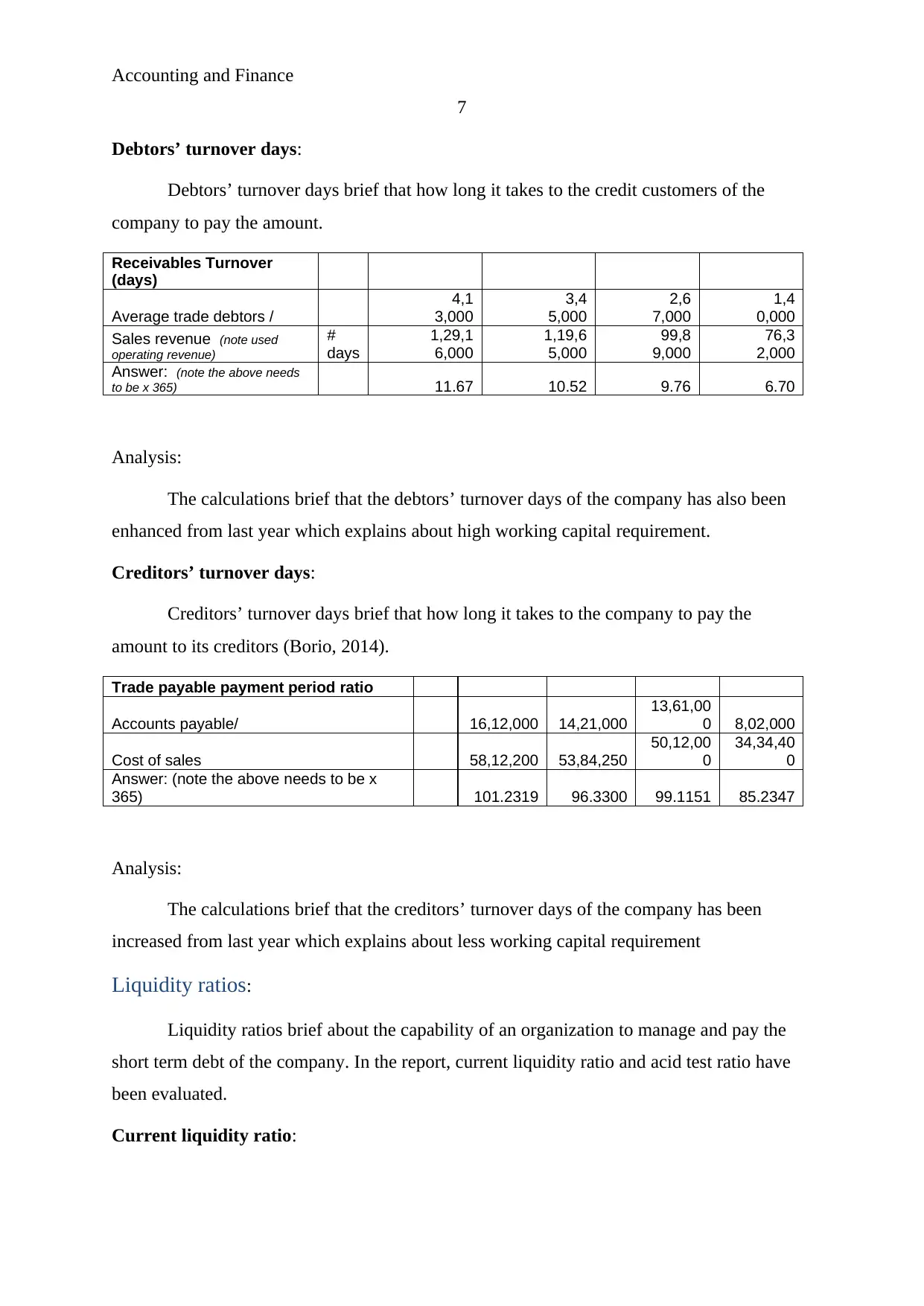
Accounting and Finance
7
Debtors’ turnover days:
Debtors’ turnover days brief that how long it takes to the credit customers of the
company to pay the amount.
Receivables Turnover
(days)
Average trade debtors /
4,1
3,000
3,4
5,000
2,6
7,000
1,4
0,000
Sales revenue (note used
operating revenue)
#
days
1,29,1
6,000
1,19,6
5,000
99,8
9,000
76,3
2,000
Answer: (note the above needs
to be x 365) 11.67 10.52 9.76 6.70
Analysis:
The calculations brief that the debtors’ turnover days of the company has also been
enhanced from last year which explains about high working capital requirement.
Creditors’ turnover days:
Creditors’ turnover days brief that how long it takes to the company to pay the
amount to its creditors (Borio, 2014).
Trade payable payment period ratio
Accounts payable/ 16,12,000 14,21,000
13,61,00
0 8,02,000
Cost of sales 58,12,200 53,84,250
50,12,00
0
34,34,40
0
Answer: (note the above needs to be x
365) 101.2319 96.3300 99.1151 85.2347
Analysis:
The calculations brief that the creditors’ turnover days of the company has been
increased from last year which explains about less working capital requirement
Liquidity ratios:
Liquidity ratios brief about the capability of an organization to manage and pay the
short term debt of the company. In the report, current liquidity ratio and acid test ratio have
been evaluated.
Current liquidity ratio:
7
Debtors’ turnover days:
Debtors’ turnover days brief that how long it takes to the credit customers of the
company to pay the amount.
Receivables Turnover
(days)
Average trade debtors /
4,1
3,000
3,4
5,000
2,6
7,000
1,4
0,000
Sales revenue (note used
operating revenue)
#
days
1,29,1
6,000
1,19,6
5,000
99,8
9,000
76,3
2,000
Answer: (note the above needs
to be x 365) 11.67 10.52 9.76 6.70
Analysis:
The calculations brief that the debtors’ turnover days of the company has also been
enhanced from last year which explains about high working capital requirement.
Creditors’ turnover days:
Creditors’ turnover days brief that how long it takes to the company to pay the
amount to its creditors (Borio, 2014).
Trade payable payment period ratio
Accounts payable/ 16,12,000 14,21,000
13,61,00
0 8,02,000
Cost of sales 58,12,200 53,84,250
50,12,00
0
34,34,40
0
Answer: (note the above needs to be x
365) 101.2319 96.3300 99.1151 85.2347
Analysis:
The calculations brief that the creditors’ turnover days of the company has been
increased from last year which explains about less working capital requirement
Liquidity ratios:
Liquidity ratios brief about the capability of an organization to manage and pay the
short term debt of the company. In the report, current liquidity ratio and acid test ratio have
been evaluated.
Current liquidity ratio:
Paraphrase This Document
Need a fresh take? Get an instant paraphrase of this document with our AI Paraphraser

Accounting and Finance
8
Current liquidity ratio brief about the ability of the company pay off all the current
liabilities of the company on the basis of current assets of the company.
Current Ratio
Current Assets /
53,34,000.0
0
47,02,000.0
0
45,59,000.0
0
25,73,000.0
0
Current liabilities
55,50,000.0
0
43,26,000.0
0
42,04,000.0
0
25,19,000.0
0
Answer: 0.96 1.09 1.08 1.02
Analysis:
The calculations of current ratio brief that the level of liquidity position has been
lowered from last year. The company is required to maintain a competitive level.
Acid test ratio:
Acid test ratio brief about the ability of the company pay off all the current liabilities
of the company on the basis of quick assets of the company.
Acid test ratio
Current Assets - Inventory / 42,21,000 37,12,000 37,12,000 20,27,000
Current Liabilities 55,50,000 43,26,000 42,04,000 25,19,000
Answer: 0.76 0.86 0.88 0.80
Analysis:
The calculations of current ratio brief that the level of liquidity position has been
lowered from last year. The company is required to reduce the level of current liabilities to
maintain a competitive level.
Capital structure ratios:
Capital structure ratio briefs about the capability of an organization to manage its
capital structure such as debts and equity (Kaplan and Atkinson, 2015). In the report, gearing
ratios and interest coverage ratio have been evaluated.
Gearing ratios:
Gearing ratio briefs the position of capital structure of a company. It evaluates the
long term liabilities and long term funds of the company.
Gearing ratio
Long term 90,41,000 96,43,000 79,30,000 28,58,000
8
Current liquidity ratio brief about the ability of the company pay off all the current
liabilities of the company on the basis of current assets of the company.
Current Ratio
Current Assets /
53,34,000.0
0
47,02,000.0
0
45,59,000.0
0
25,73,000.0
0
Current liabilities
55,50,000.0
0
43,26,000.0
0
42,04,000.0
0
25,19,000.0
0
Answer: 0.96 1.09 1.08 1.02
Analysis:
The calculations of current ratio brief that the level of liquidity position has been
lowered from last year. The company is required to maintain a competitive level.
Acid test ratio:
Acid test ratio brief about the ability of the company pay off all the current liabilities
of the company on the basis of quick assets of the company.
Acid test ratio
Current Assets - Inventory / 42,21,000 37,12,000 37,12,000 20,27,000
Current Liabilities 55,50,000 43,26,000 42,04,000 25,19,000
Answer: 0.76 0.86 0.88 0.80
Analysis:
The calculations of current ratio brief that the level of liquidity position has been
lowered from last year. The company is required to reduce the level of current liabilities to
maintain a competitive level.
Capital structure ratios:
Capital structure ratio briefs about the capability of an organization to manage its
capital structure such as debts and equity (Kaplan and Atkinson, 2015). In the report, gearing
ratios and interest coverage ratio have been evaluated.
Gearing ratios:
Gearing ratio briefs the position of capital structure of a company. It evaluates the
long term liabilities and long term funds of the company.
Gearing ratio
Long term 90,41,000 96,43,000 79,30,000 28,58,000
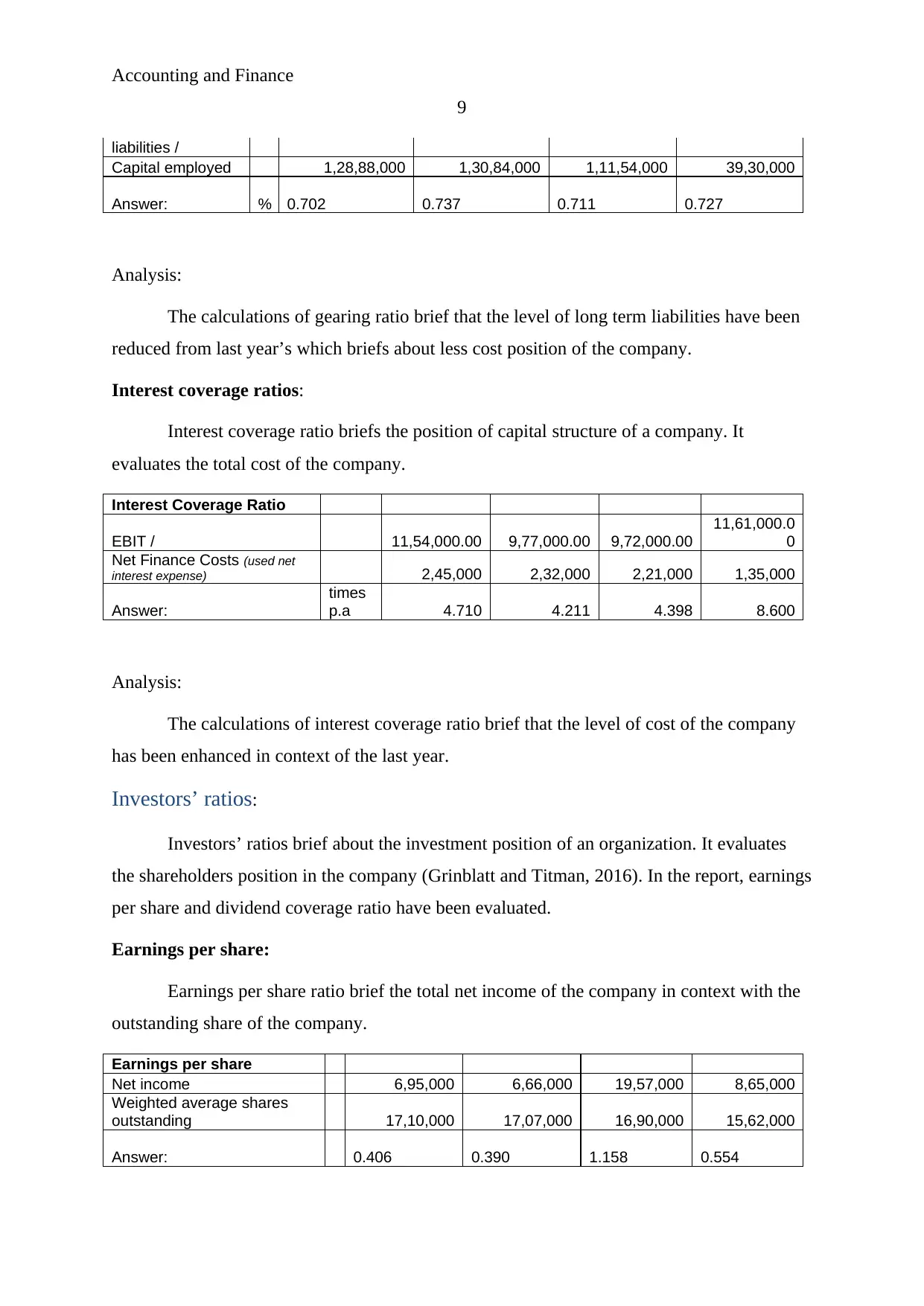
Accounting and Finance
9
liabilities /
Capital employed 1,28,88,000 1,30,84,000 1,11,54,000 39,30,000
Answer: % 0.702 0.737 0.711 0.727
Analysis:
The calculations of gearing ratio brief that the level of long term liabilities have been
reduced from last year’s which briefs about less cost position of the company.
Interest coverage ratios:
Interest coverage ratio briefs the position of capital structure of a company. It
evaluates the total cost of the company.
Interest Coverage Ratio
EBIT / 11,54,000.00 9,77,000.00 9,72,000.00
11,61,000.0
0
Net Finance Costs (used net
interest expense) 2,45,000 2,32,000 2,21,000 1,35,000
Answer:
times
p.a 4.710 4.211 4.398 8.600
Analysis:
The calculations of interest coverage ratio brief that the level of cost of the company
has been enhanced in context of the last year.
Investors’ ratios:
Investors’ ratios brief about the investment position of an organization. It evaluates
the shareholders position in the company (Grinblatt and Titman, 2016). In the report, earnings
per share and dividend coverage ratio have been evaluated.
Earnings per share:
Earnings per share ratio brief the total net income of the company in context with the
outstanding share of the company.
Earnings per share
Net income 6,95,000 6,66,000 19,57,000 8,65,000
Weighted average shares
outstanding 17,10,000 17,07,000 16,90,000 15,62,000
Answer: 0.406 0.390 1.158 0.554
9
liabilities /
Capital employed 1,28,88,000 1,30,84,000 1,11,54,000 39,30,000
Answer: % 0.702 0.737 0.711 0.727
Analysis:
The calculations of gearing ratio brief that the level of long term liabilities have been
reduced from last year’s which briefs about less cost position of the company.
Interest coverage ratios:
Interest coverage ratio briefs the position of capital structure of a company. It
evaluates the total cost of the company.
Interest Coverage Ratio
EBIT / 11,54,000.00 9,77,000.00 9,72,000.00
11,61,000.0
0
Net Finance Costs (used net
interest expense) 2,45,000 2,32,000 2,21,000 1,35,000
Answer:
times
p.a 4.710 4.211 4.398 8.600
Analysis:
The calculations of interest coverage ratio brief that the level of cost of the company
has been enhanced in context of the last year.
Investors’ ratios:
Investors’ ratios brief about the investment position of an organization. It evaluates
the shareholders position in the company (Grinblatt and Titman, 2016). In the report, earnings
per share and dividend coverage ratio have been evaluated.
Earnings per share:
Earnings per share ratio brief the total net income of the company in context with the
outstanding share of the company.
Earnings per share
Net income 6,95,000 6,66,000 19,57,000 8,65,000
Weighted average shares
outstanding 17,10,000 17,07,000 16,90,000 15,62,000
Answer: 0.406 0.390 1.158 0.554
⊘ This is a preview!⊘
Do you want full access?
Subscribe today to unlock all pages.

Trusted by 1+ million students worldwide
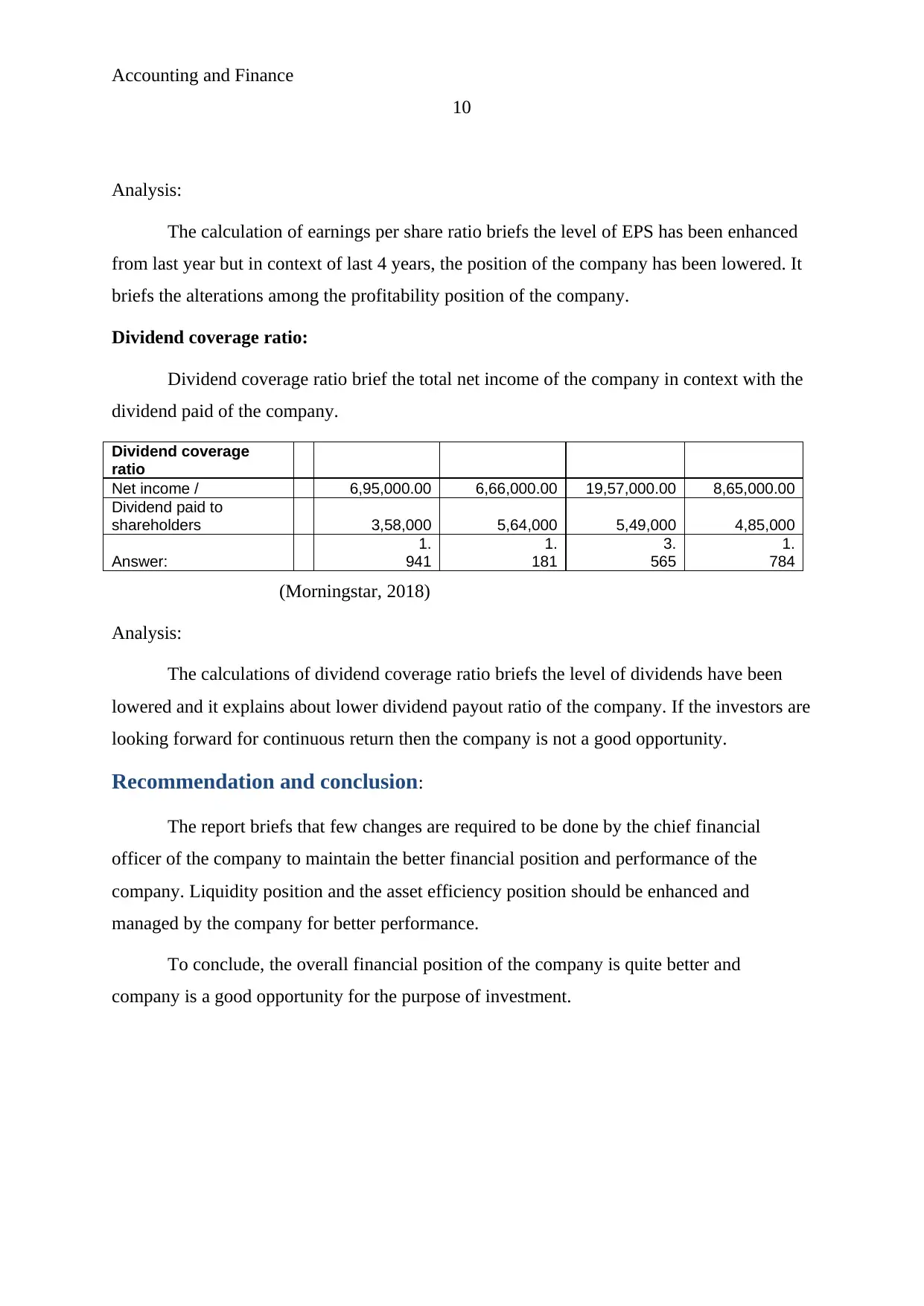
Accounting and Finance
10
Analysis:
The calculation of earnings per share ratio briefs the level of EPS has been enhanced
from last year but in context of last 4 years, the position of the company has been lowered. It
briefs the alterations among the profitability position of the company.
Dividend coverage ratio:
Dividend coverage ratio brief the total net income of the company in context with the
dividend paid of the company.
Dividend coverage
ratio
Net income / 6,95,000.00 6,66,000.00 19,57,000.00 8,65,000.00
Dividend paid to
shareholders 3,58,000 5,64,000 5,49,000 4,85,000
Answer:
1.
941
1.
181
3.
565
1.
784
(Morningstar, 2018)
Analysis:
The calculations of dividend coverage ratio briefs the level of dividends have been
lowered and it explains about lower dividend payout ratio of the company. If the investors are
looking forward for continuous return then the company is not a good opportunity.
Recommendation and conclusion:
The report briefs that few changes are required to be done by the chief financial
officer of the company to maintain the better financial position and performance of the
company. Liquidity position and the asset efficiency position should be enhanced and
managed by the company for better performance.
To conclude, the overall financial position of the company is quite better and
company is a good opportunity for the purpose of investment.
10
Analysis:
The calculation of earnings per share ratio briefs the level of EPS has been enhanced
from last year but in context of last 4 years, the position of the company has been lowered. It
briefs the alterations among the profitability position of the company.
Dividend coverage ratio:
Dividend coverage ratio brief the total net income of the company in context with the
dividend paid of the company.
Dividend coverage
ratio
Net income / 6,95,000.00 6,66,000.00 19,57,000.00 8,65,000.00
Dividend paid to
shareholders 3,58,000 5,64,000 5,49,000 4,85,000
Answer:
1.
941
1.
181
3.
565
1.
784
(Morningstar, 2018)
Analysis:
The calculations of dividend coverage ratio briefs the level of dividends have been
lowered and it explains about lower dividend payout ratio of the company. If the investors are
looking forward for continuous return then the company is not a good opportunity.
Recommendation and conclusion:
The report briefs that few changes are required to be done by the chief financial
officer of the company to maintain the better financial position and performance of the
company. Liquidity position and the asset efficiency position should be enhanced and
managed by the company for better performance.
To conclude, the overall financial position of the company is quite better and
company is a good opportunity for the purpose of investment.
Paraphrase This Document
Need a fresh take? Get an instant paraphrase of this document with our AI Paraphraser
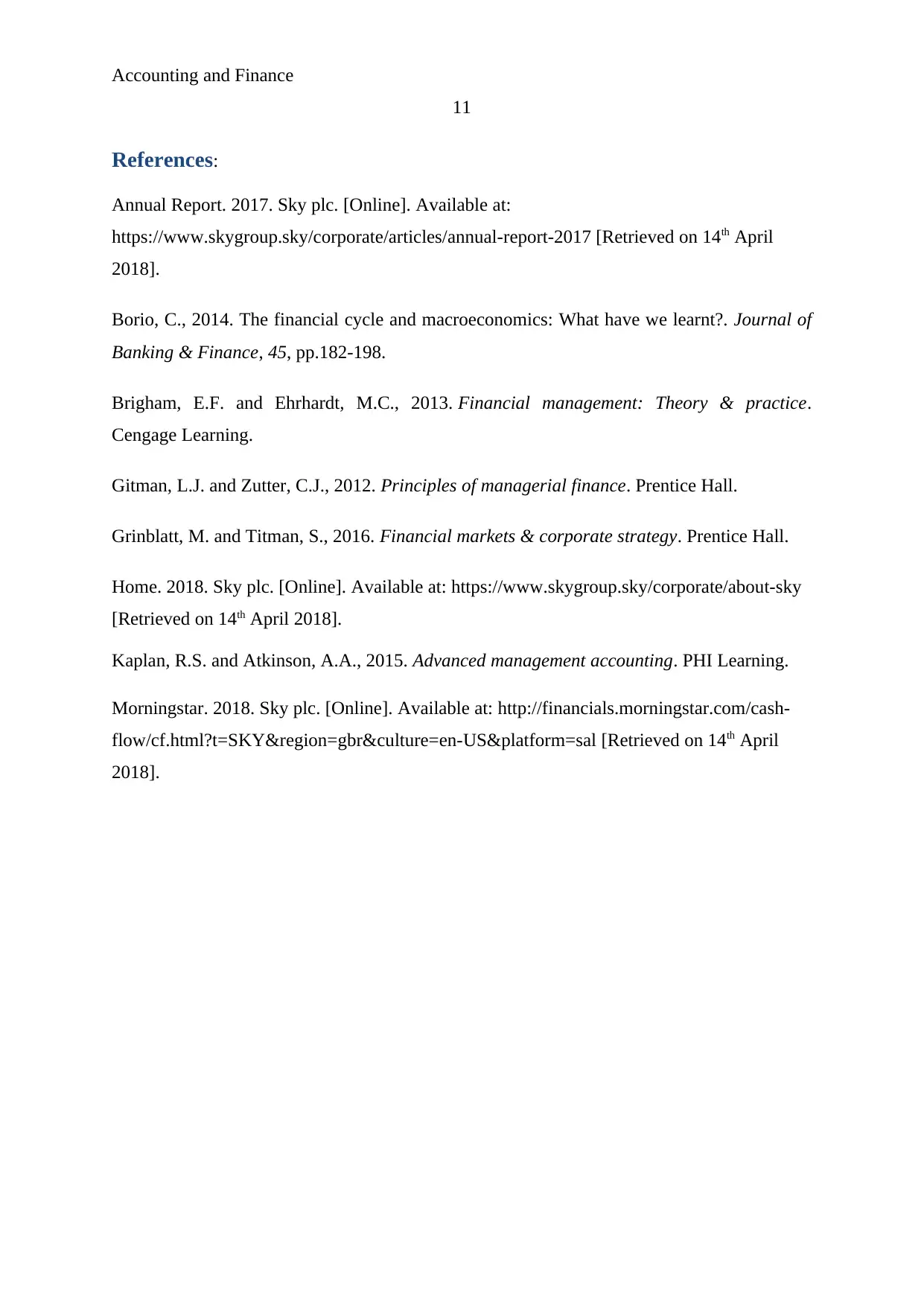
Accounting and Finance
11
References:
Annual Report. 2017. Sky plc. [Online]. Available at:
https://www.skygroup.sky/corporate/articles/annual-report-2017 [Retrieved on 14th April
2018].
Borio, C., 2014. The financial cycle and macroeconomics: What have we learnt?. Journal of
Banking & Finance, 45, pp.182-198.
Brigham, E.F. and Ehrhardt, M.C., 2013. Financial management: Theory & practice.
Cengage Learning.
Gitman, L.J. and Zutter, C.J., 2012. Principles of managerial finance. Prentice Hall.
Grinblatt, M. and Titman, S., 2016. Financial markets & corporate strategy. Prentice Hall.
Home. 2018. Sky plc. [Online]. Available at: https://www.skygroup.sky/corporate/about-sky
[Retrieved on 14th April 2018].
Kaplan, R.S. and Atkinson, A.A., 2015. Advanced management accounting. PHI Learning.
Morningstar. 2018. Sky plc. [Online]. Available at: http://financials.morningstar.com/cash-
flow/cf.html?t=SKY®ion=gbr&culture=en-US&platform=sal [Retrieved on 14th April
2018].
11
References:
Annual Report. 2017. Sky plc. [Online]. Available at:
https://www.skygroup.sky/corporate/articles/annual-report-2017 [Retrieved on 14th April
2018].
Borio, C., 2014. The financial cycle and macroeconomics: What have we learnt?. Journal of
Banking & Finance, 45, pp.182-198.
Brigham, E.F. and Ehrhardt, M.C., 2013. Financial management: Theory & practice.
Cengage Learning.
Gitman, L.J. and Zutter, C.J., 2012. Principles of managerial finance. Prentice Hall.
Grinblatt, M. and Titman, S., 2016. Financial markets & corporate strategy. Prentice Hall.
Home. 2018. Sky plc. [Online]. Available at: https://www.skygroup.sky/corporate/about-sky
[Retrieved on 14th April 2018].
Kaplan, R.S. and Atkinson, A.A., 2015. Advanced management accounting. PHI Learning.
Morningstar. 2018. Sky plc. [Online]. Available at: http://financials.morningstar.com/cash-
flow/cf.html?t=SKY®ion=gbr&culture=en-US&platform=sal [Retrieved on 14th April
2018].
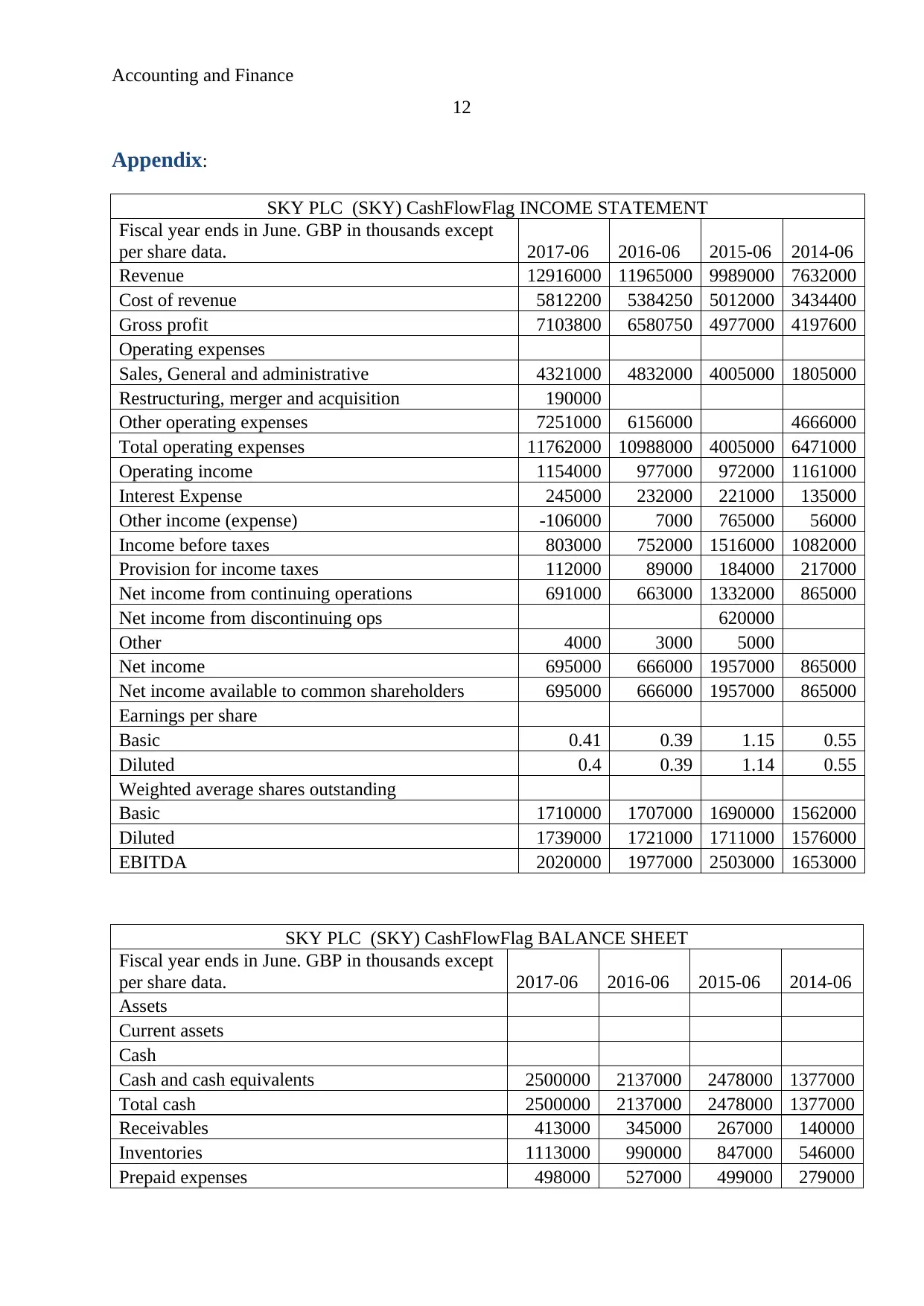
Accounting and Finance
12
Appendix:
SKY PLC (SKY) CashFlowFlag INCOME STATEMENT
Fiscal year ends in June. GBP in thousands except
per share data. 2017-06 2016-06 2015-06 2014-06
Revenue 12916000 11965000 9989000 7632000
Cost of revenue 5812200 5384250 5012000 3434400
Gross profit 7103800 6580750 4977000 4197600
Operating expenses
Sales, General and administrative 4321000 4832000 4005000 1805000
Restructuring, merger and acquisition 190000
Other operating expenses 7251000 6156000 4666000
Total operating expenses 11762000 10988000 4005000 6471000
Operating income 1154000 977000 972000 1161000
Interest Expense 245000 232000 221000 135000
Other income (expense) -106000 7000 765000 56000
Income before taxes 803000 752000 1516000 1082000
Provision for income taxes 112000 89000 184000 217000
Net income from continuing operations 691000 663000 1332000 865000
Net income from discontinuing ops 620000
Other 4000 3000 5000
Net income 695000 666000 1957000 865000
Net income available to common shareholders 695000 666000 1957000 865000
Earnings per share
Basic 0.41 0.39 1.15 0.55
Diluted 0.4 0.39 1.14 0.55
Weighted average shares outstanding
Basic 1710000 1707000 1690000 1562000
Diluted 1739000 1721000 1711000 1576000
EBITDA 2020000 1977000 2503000 1653000
SKY PLC (SKY) CashFlowFlag BALANCE SHEET
Fiscal year ends in June. GBP in thousands except
per share data. 2017-06 2016-06 2015-06 2014-06
Assets
Current assets
Cash
Cash and cash equivalents 2500000 2137000 2478000 1377000
Total cash 2500000 2137000 2478000 1377000
Receivables 413000 345000 267000 140000
Inventories 1113000 990000 847000 546000
Prepaid expenses 498000 527000 499000 279000
12
Appendix:
SKY PLC (SKY) CashFlowFlag INCOME STATEMENT
Fiscal year ends in June. GBP in thousands except
per share data. 2017-06 2016-06 2015-06 2014-06
Revenue 12916000 11965000 9989000 7632000
Cost of revenue 5812200 5384250 5012000 3434400
Gross profit 7103800 6580750 4977000 4197600
Operating expenses
Sales, General and administrative 4321000 4832000 4005000 1805000
Restructuring, merger and acquisition 190000
Other operating expenses 7251000 6156000 4666000
Total operating expenses 11762000 10988000 4005000 6471000
Operating income 1154000 977000 972000 1161000
Interest Expense 245000 232000 221000 135000
Other income (expense) -106000 7000 765000 56000
Income before taxes 803000 752000 1516000 1082000
Provision for income taxes 112000 89000 184000 217000
Net income from continuing operations 691000 663000 1332000 865000
Net income from discontinuing ops 620000
Other 4000 3000 5000
Net income 695000 666000 1957000 865000
Net income available to common shareholders 695000 666000 1957000 865000
Earnings per share
Basic 0.41 0.39 1.15 0.55
Diluted 0.4 0.39 1.14 0.55
Weighted average shares outstanding
Basic 1710000 1707000 1690000 1562000
Diluted 1739000 1721000 1711000 1576000
EBITDA 2020000 1977000 2503000 1653000
SKY PLC (SKY) CashFlowFlag BALANCE SHEET
Fiscal year ends in June. GBP in thousands except
per share data. 2017-06 2016-06 2015-06 2014-06
Assets
Current assets
Cash
Cash and cash equivalents 2500000 2137000 2478000 1377000
Total cash 2500000 2137000 2478000 1377000
Receivables 413000 345000 267000 140000
Inventories 1113000 990000 847000 546000
Prepaid expenses 498000 527000 499000 279000
⊘ This is a preview!⊘
Do you want full access?
Subscribe today to unlock all pages.

Trusted by 1+ million students worldwide
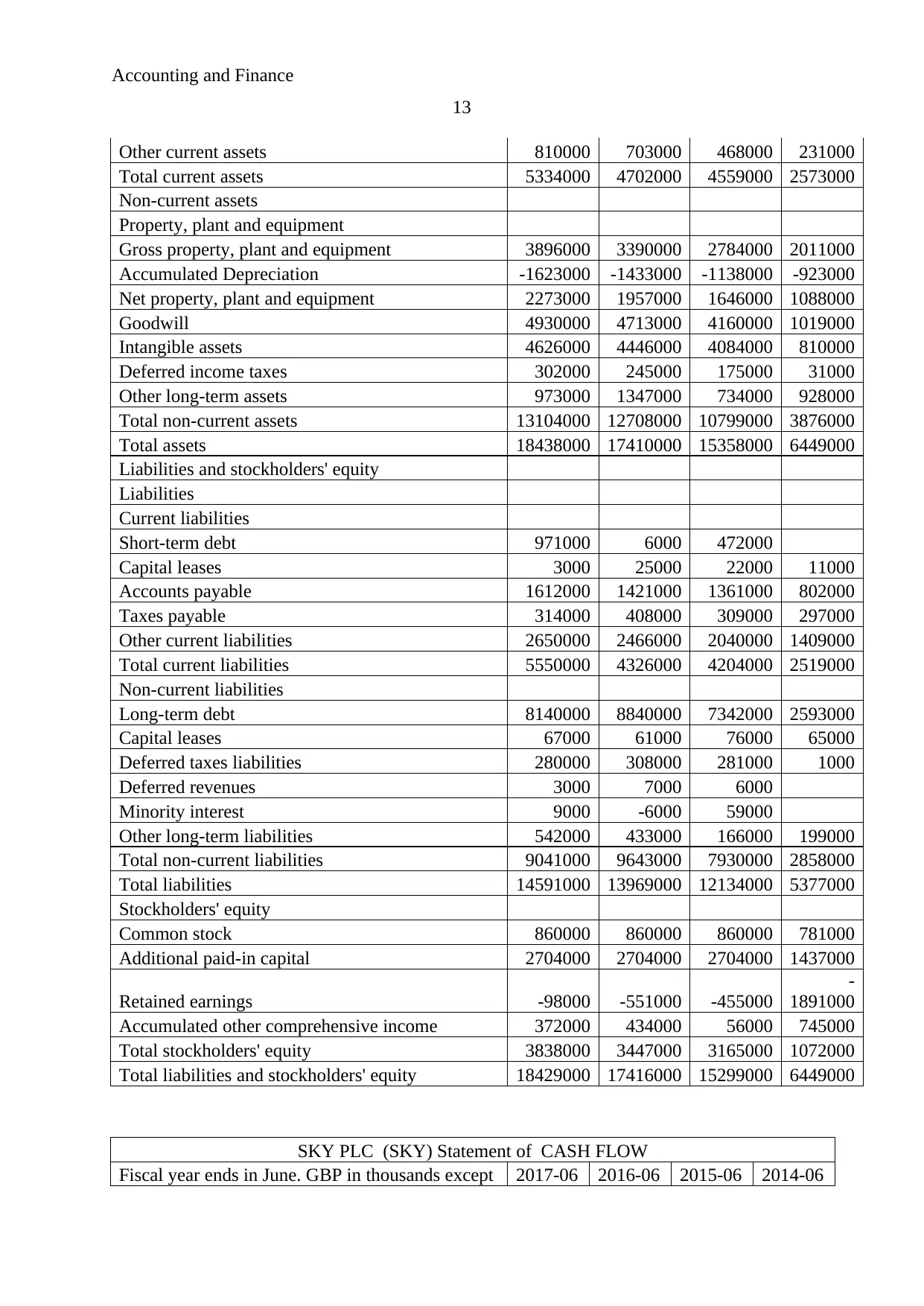
Accounting and Finance
13
Other current assets 810000 703000 468000 231000
Total current assets 5334000 4702000 4559000 2573000
Non-current assets
Property, plant and equipment
Gross property, plant and equipment 3896000 3390000 2784000 2011000
Accumulated Depreciation -1623000 -1433000 -1138000 -923000
Net property, plant and equipment 2273000 1957000 1646000 1088000
Goodwill 4930000 4713000 4160000 1019000
Intangible assets 4626000 4446000 4084000 810000
Deferred income taxes 302000 245000 175000 31000
Other long-term assets 973000 1347000 734000 928000
Total non-current assets 13104000 12708000 10799000 3876000
Total assets 18438000 17410000 15358000 6449000
Liabilities and stockholders' equity
Liabilities
Current liabilities
Short-term debt 971000 6000 472000
Capital leases 3000 25000 22000 11000
Accounts payable 1612000 1421000 1361000 802000
Taxes payable 314000 408000 309000 297000
Other current liabilities 2650000 2466000 2040000 1409000
Total current liabilities 5550000 4326000 4204000 2519000
Non-current liabilities
Long-term debt 8140000 8840000 7342000 2593000
Capital leases 67000 61000 76000 65000
Deferred taxes liabilities 280000 308000 281000 1000
Deferred revenues 3000 7000 6000
Minority interest 9000 -6000 59000
Other long-term liabilities 542000 433000 166000 199000
Total non-current liabilities 9041000 9643000 7930000 2858000
Total liabilities 14591000 13969000 12134000 5377000
Stockholders' equity
Common stock 860000 860000 860000 781000
Additional paid-in capital 2704000 2704000 2704000 1437000
Retained earnings -98000 -551000 -455000
-
1891000
Accumulated other comprehensive income 372000 434000 56000 745000
Total stockholders' equity 3838000 3447000 3165000 1072000
Total liabilities and stockholders' equity 18429000 17416000 15299000 6449000
SKY PLC (SKY) Statement of CASH FLOW
Fiscal year ends in June. GBP in thousands except 2017-06 2016-06 2015-06 2014-06
13
Other current assets 810000 703000 468000 231000
Total current assets 5334000 4702000 4559000 2573000
Non-current assets
Property, plant and equipment
Gross property, plant and equipment 3896000 3390000 2784000 2011000
Accumulated Depreciation -1623000 -1433000 -1138000 -923000
Net property, plant and equipment 2273000 1957000 1646000 1088000
Goodwill 4930000 4713000 4160000 1019000
Intangible assets 4626000 4446000 4084000 810000
Deferred income taxes 302000 245000 175000 31000
Other long-term assets 973000 1347000 734000 928000
Total non-current assets 13104000 12708000 10799000 3876000
Total assets 18438000 17410000 15358000 6449000
Liabilities and stockholders' equity
Liabilities
Current liabilities
Short-term debt 971000 6000 472000
Capital leases 3000 25000 22000 11000
Accounts payable 1612000 1421000 1361000 802000
Taxes payable 314000 408000 309000 297000
Other current liabilities 2650000 2466000 2040000 1409000
Total current liabilities 5550000 4326000 4204000 2519000
Non-current liabilities
Long-term debt 8140000 8840000 7342000 2593000
Capital leases 67000 61000 76000 65000
Deferred taxes liabilities 280000 308000 281000 1000
Deferred revenues 3000 7000 6000
Minority interest 9000 -6000 59000
Other long-term liabilities 542000 433000 166000 199000
Total non-current liabilities 9041000 9643000 7930000 2858000
Total liabilities 14591000 13969000 12134000 5377000
Stockholders' equity
Common stock 860000 860000 860000 781000
Additional paid-in capital 2704000 2704000 2704000 1437000
Retained earnings -98000 -551000 -455000
-
1891000
Accumulated other comprehensive income 372000 434000 56000 745000
Total stockholders' equity 3838000 3447000 3165000 1072000
Total liabilities and stockholders' equity 18429000 17416000 15299000 6449000
SKY PLC (SKY) Statement of CASH FLOW
Fiscal year ends in June. GBP in thousands except 2017-06 2016-06 2015-06 2014-06
Paraphrase This Document
Need a fresh take? Get an instant paraphrase of this document with our AI Paraphraser
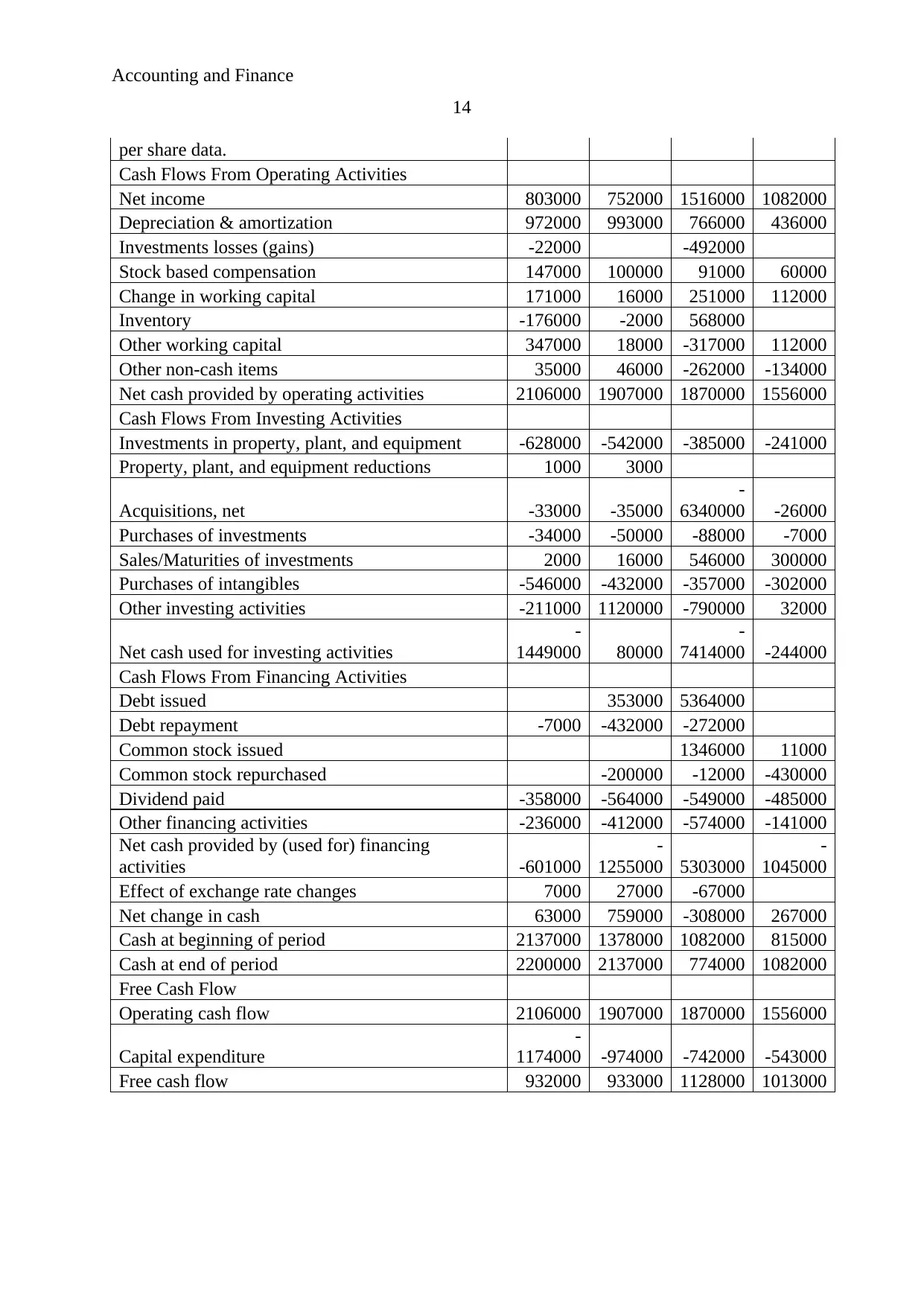
Accounting and Finance
14
per share data.
Cash Flows From Operating Activities
Net income 803000 752000 1516000 1082000
Depreciation & amortization 972000 993000 766000 436000
Investments losses (gains) -22000 -492000
Stock based compensation 147000 100000 91000 60000
Change in working capital 171000 16000 251000 112000
Inventory -176000 -2000 568000
Other working capital 347000 18000 -317000 112000
Other non-cash items 35000 46000 -262000 -134000
Net cash provided by operating activities 2106000 1907000 1870000 1556000
Cash Flows From Investing Activities
Investments in property, plant, and equipment -628000 -542000 -385000 -241000
Property, plant, and equipment reductions 1000 3000
Acquisitions, net -33000 -35000
-
6340000 -26000
Purchases of investments -34000 -50000 -88000 -7000
Sales/Maturities of investments 2000 16000 546000 300000
Purchases of intangibles -546000 -432000 -357000 -302000
Other investing activities -211000 1120000 -790000 32000
Net cash used for investing activities
-
1449000 80000
-
7414000 -244000
Cash Flows From Financing Activities
Debt issued 353000 5364000
Debt repayment -7000 -432000 -272000
Common stock issued 1346000 11000
Common stock repurchased -200000 -12000 -430000
Dividend paid -358000 -564000 -549000 -485000
Other financing activities -236000 -412000 -574000 -141000
Net cash provided by (used for) financing
activities -601000
-
1255000 5303000
-
1045000
Effect of exchange rate changes 7000 27000 -67000
Net change in cash 63000 759000 -308000 267000
Cash at beginning of period 2137000 1378000 1082000 815000
Cash at end of period 2200000 2137000 774000 1082000
Free Cash Flow
Operating cash flow 2106000 1907000 1870000 1556000
Capital expenditure
-
1174000 -974000 -742000 -543000
Free cash flow 932000 933000 1128000 1013000
14
per share data.
Cash Flows From Operating Activities
Net income 803000 752000 1516000 1082000
Depreciation & amortization 972000 993000 766000 436000
Investments losses (gains) -22000 -492000
Stock based compensation 147000 100000 91000 60000
Change in working capital 171000 16000 251000 112000
Inventory -176000 -2000 568000
Other working capital 347000 18000 -317000 112000
Other non-cash items 35000 46000 -262000 -134000
Net cash provided by operating activities 2106000 1907000 1870000 1556000
Cash Flows From Investing Activities
Investments in property, plant, and equipment -628000 -542000 -385000 -241000
Property, plant, and equipment reductions 1000 3000
Acquisitions, net -33000 -35000
-
6340000 -26000
Purchases of investments -34000 -50000 -88000 -7000
Sales/Maturities of investments 2000 16000 546000 300000
Purchases of intangibles -546000 -432000 -357000 -302000
Other investing activities -211000 1120000 -790000 32000
Net cash used for investing activities
-
1449000 80000
-
7414000 -244000
Cash Flows From Financing Activities
Debt issued 353000 5364000
Debt repayment -7000 -432000 -272000
Common stock issued 1346000 11000
Common stock repurchased -200000 -12000 -430000
Dividend paid -358000 -564000 -549000 -485000
Other financing activities -236000 -412000 -574000 -141000
Net cash provided by (used for) financing
activities -601000
-
1255000 5303000
-
1045000
Effect of exchange rate changes 7000 27000 -67000
Net change in cash 63000 759000 -308000 267000
Cash at beginning of period 2137000 1378000 1082000 815000
Cash at end of period 2200000 2137000 774000 1082000
Free Cash Flow
Operating cash flow 2106000 1907000 1870000 1556000
Capital expenditure
-
1174000 -974000 -742000 -543000
Free cash flow 932000 933000 1128000 1013000
1 out of 14
Related Documents
Your All-in-One AI-Powered Toolkit for Academic Success.
+13062052269
info@desklib.com
Available 24*7 on WhatsApp / Email
![[object Object]](/_next/static/media/star-bottom.7253800d.svg)
Unlock your academic potential
© 2024 | Zucol Services PVT LTD | All rights reserved.



